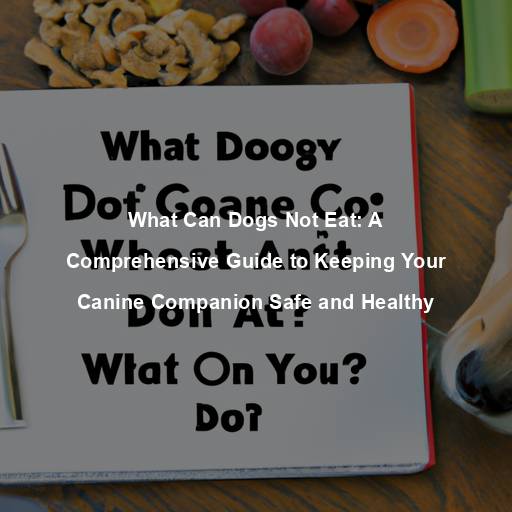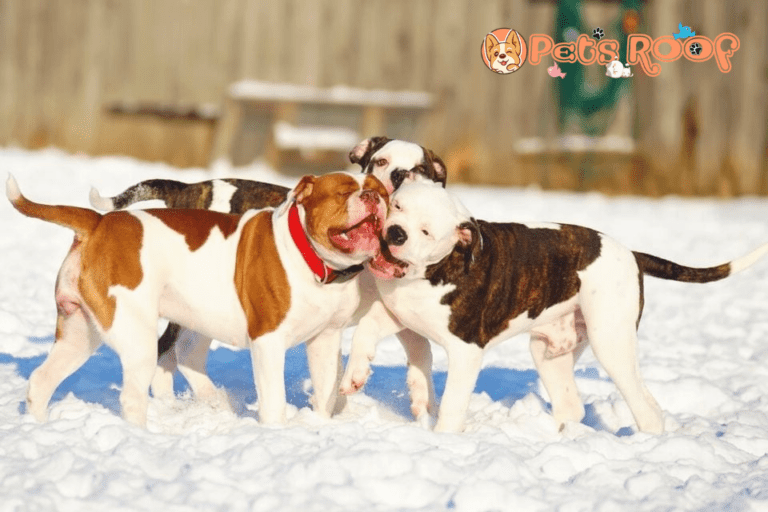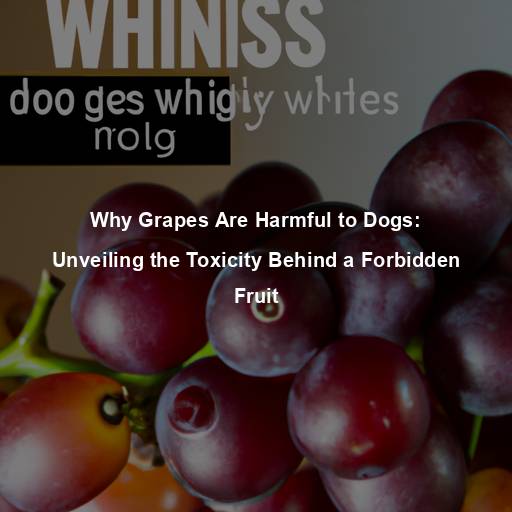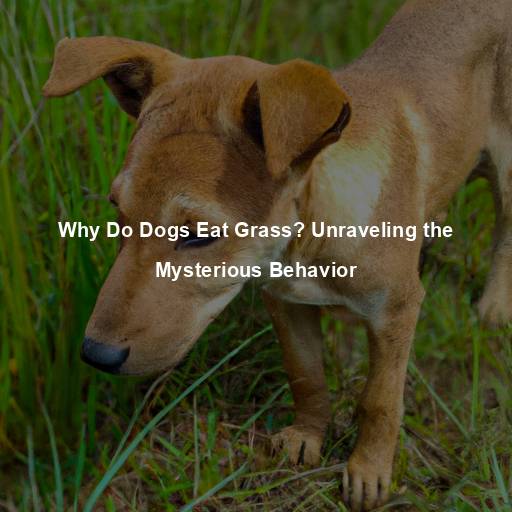What Can Dogs Not Eat: A Comprehensive Guide to Keeping Your Canine Companion Safe and Healthy
Last Updated on July 21, 2023 by Evan
Contents
- 1 Understanding the Importance of a Balanced Diet for Dogs
- 2 The Dangers of Feeding Dogs Certain Human Foods
- 3 Other Foods to Avoid for Your Dog’s Safety
- 3.1 Avocado: A Fruit Best Left for Human Consumption
- 3.2 Caffeine: A Stimulant That Should Be Kept Away from Dogs
- 3.3 Macadamia Nuts: A Nutritional Snack That’s Off-Limits for Dogs
- 3.4 Raw Meat and Fish: Potential Sources of Bacterial Contamination
- 3.5 Salt: A Seasoning That Should Be Used in Moderation
- 4 Consulting Your Veterinarian: The Key to a Safe and Healthy Diet for Your Dog
- 5 Safe and Healthy Treat Alternatives for Dogs
- 6 FAQs: What Can Dogs Not Eat
- 6.1 What foods are toxic to dogs?
- 6.2 Can dogs eat human snacks like chips or pretzels?
- 6.3 Is it safe to give dogs bones to chew on?
- 6.4 Are there any fruits or vegetables that dogs should not eat?
- 6.5 Can dogs eat dairy products like milk or cheese?
- 6.6 Are there any other common foods that dogs should avoid?
Understanding the Importance of a Balanced Diet for Dogs
Feeding our beloved canine companions a well-balanced and nutritious diet is essential for their overall health and well-being. As responsible pet owners, it is our duty to ensure that we provide them with the right food choices to keep them happy and healthy. While there are many foods that dogs can safely consume, it is important to be aware of the foods that can be harmful or even toxic to them. In this comprehensive guide, we will explore the question, “What can dogs not eat”?
The Dangers of Feeding Dogs Certain Human Foods
Chocolate: A Sweet Treat That Spells Trouble for Dogs
Chocolate is undoubtedly one of those guilty pleasures that can make our taste buds dance with delight. However, when it comes to our furry friends, caution should be exercised. Why? Well, it turns out that chocolate contains substances like theobromine and caffeine, which can spell trouble for our beloved canines.
Grapes and Raisins: A Hidden Danger in Fruit
While fruits are generally considered healthy for humans, certain varieties can pose a serious threat to dogs. Grapes and raisins, although seemingly harmless, can cause kidney failure in dogs. The exact toxic substance in these fruits is still unknown, making it vital to err on the side of caution and avoid feeding them to your furry friend. Keep grapes and raisins securely stored away, as even a small amount can have detrimental effects on your dog’s health.
It’s a rather perplexing fact that something as common as onions and garlic can actually be harmful to our furry friends. Bursting with flavor and often found in a variety of delicious dishes, these seemingly harmless vegetables can lead to a serious condition known as hemolytic anemia in dogs. This unexpected turn of events can leave our four-legged companions weak, lethargic, and with pale gums – even resulting in collapse. So, it’s wise to steer clear of feeding them any meals seasoned with onions or garlic, such as enticing soups, flavorful sauces, or even certain baby foods.
Xylitol: A Hidden Sweetener That Spells Trouble
Beware, fellow pet owners! A hidden peril may lurk within our innocent sugar-free treats and confections. Xylitol, the sneaky impostor, can bring peril upon our precious dogs. Your furry companion, unsuspecting, consumes this deceptive substance, triggering a chaotic chain reaction inside their delicate bodies.
Alcohol: A Serious Hazard for Dogs
Contrary to popular belief, alcohol should never be given to dogs, even in small amounts. Dogs are far more sensitive to the effects of alcohol than humans, and even a small quantity can have serious consequences. Ingesting alcohol can lead to symptoms such as disorientation, lack of coordination, vomiting, diarrhea, difficulty breathing, and in severe cases, coma or death. It is imperative to keep alcoholic beverages out of reach and ensure that spills are cleaned up promptly to prevent accidental ingestion.
Other Foods to Avoid for Your Dog’s Safety
Avocado: A Fruit Best Left for Human Consumption
Avocados, while undoubtedly a delectable and nourishing indulgence for us, can be quite perilous for our beloved canine companions. Concealed within this coveted fruit is a compound known as persin, which, alas, can trigger unfortunate bouts of vomiting and diarrhea in our furry friends. Moreover, the sizable pit, regrettably, carries the potential for asphyxiation and intestinal obstructions if ever consumed by our four-legged pals. Thus, it behooves us to judiciously keep avocados beyond the grasp of our dogs and abstain from gifting them any fare that boasts an avocado-based pedigree.
Caffeine: A Stimulant That Should Be Kept Away from Dogs
Caffeine, found in coffee, tea, energy drinks, and certain medications, can be toxic to dogs. Similar to chocolate, caffeine contains theobromine, which can cause restlessness, rapid breathing, increased heart rate, tremors, and in severe cases, seizures or even death. It is important to keep caffeinated products securely stored and to seek immediate veterinary care if your dog accidentally ingests any caffeine-containing substances.
Macadamia Nuts: A Nutritional Snack That’s Off-Limits for Dogs
When it comes to the tantalizing world of nuts, there is one little powerhouse that demands caution when it comes to our furry friends. Enter macadamia nuts, seemingly harmless to us humans, but hiding a perilous secret for our canine companions. These delectable treats can unleash a torrent of debilitating symptoms in dogs, causing sheer perplexity for their unsuspecting owners. From weakness to tremors, vomiting to increased body temperature, and in rare cases, even paralysis, the consequences of a nibble can be nothing short of bewildering.
Raw Meat and Fish: Potential Sources of Bacterial Contamination
When it comes to our furry friends, it’s crucial to consider their dietary needs with utmost care. While dogs are often associated with their carnivorous nature, it’s worth noting that raw meat and fish might not always be the best choice for them. You see, uncooked meat and fish can harbor dangerous bacteria like Salmonella or E. coli, which can cause not only tummy troubles for our four-legged companions but also pose a risk to our own well-being. The safest bet is to ensure that all meat and fish are cooked thoroughly before serving it to your dog, making sure to eliminate any likelihood of bacterial contamination.
Salt: A Seasoning That Should Be Used in Moderation
Although small amounts of salt are generally safe for dogs, excessive consumption can lead to sodium ion poisoning, also known as salt poisoning. Symptoms may include excessive thirst and urination, vomiting, diarrhea, tremors, seizures, and in severe cases, coma or death. It is essential to monitor your dog’s salt intake and avoid feeding them excessively salty foods, such as potato chips or pretzels.
Consulting Your Veterinarian: The Key to a Safe and Healthy Diet for Your Dog
When it comes to our furry friends, it’s crucial to stay informed about what’s on the menu and what’s a no-no. This guide covers all the bases, shedding light on the foods that can make our beloved dogs feel less like their waggy-tailed selves. However, keep in mind that our four-legged pals are a bewildering mix of quirks and complications. Some might have allergies or health issues that make certain foods a gamble.
In conclusion, understanding what dogs can and cannot eat is crucial for their well-being and longevity. By avoiding the foods mentioned in this guide, you can help keep your canine companion safe from potential health hazards. Remember, your dog relies on you to make the best choices for their diet, so be sure to prioritize their safety and consult your veterinarian whenever necessary. With the right knowledge and care, you can provide your furry friend with a healthy and fulfilling life by their side.
Storing Dog Food: Best Practices for Maintaining Freshness and Safety
Taking care of your furry friend goes beyond just feeding them the right food. Ensuring that your dog’s food remains fresh and uncontaminated is key to their well-being. By implementing a few simple best practices, you can guarantee your pet’s meals are stored safely, keeping them healthy and full of energy. Let’s explore these tips to navigate the perplexing world of dog food storage!
- Seal the Bag: After opening a bag of dog food, ensure it is tightly sealed to prevent air and moisture from entering. This will help preserve the food’s quality and prevent spoilage.
- Store in a Cool, Dry Place: Find a cool and dry area in your home to store the dog food. Avoid exposing it to direct sunlight or extreme temperatures, as this can accelerate the food’s deterioration.
When it comes to storing your furry friend’s food, airtight containers are a must-have. Keeping the kibble in these containers not only ensures freshness, but also safeguards it against unwanted critters. However, make sure your chosen container is squeaky clean and odor-free to avoid any potential cross-contamination. Give your canine companion the best by protecting their food with these simple yet effective steps.
It’s crucial to stay on top of checking those expiration dates when it comes to your furry friend’s food. Using dog food past its prime can have some unpleasant consequences, such as digestive woes and nutrient imbalances. Stay proactive and ensure that your four-legged companion is getting only the freshest and most nutritious meals to keep them happy and healthy.
When it comes to keeping your furry friend’s nutrition intact, it’s important to take measures to avoid any sneaky contaminants. One way to do this is by ensuring that your storage areas are as pure as a mountain stream, free from any potential culprits like cleaning products or chemicals. And just like you would keep your unruly socks away from your precious china, make sure to give your dog’s food its own special space, separate from other household items, to prevent any unpleasant cross-contamination scenarios.
Handling Raw Food: Precautions to Take When Feeding a Raw Diet
Some pet owners choose to feed their dogs a raw food diet, which consists of uncooked meats, bones, and fruits/vegetables. While this diet can have benefits, it is important to take certain precautions to minimize the risk of foodborne illnesses:
Maintaining proper hygiene is essential when it comes to handling raw food, ensuring the well-being of both you and your furry friend. Remember to diligently wash your hands with soap and water, creating a barrier against the potential transmission of harmful bacteria. This simple yet vital practice is a crucial step in safeguarding the health and happiness of your canine companion.
– Separate Preparation Surfaces: Use separate cutting boards, utensils, and bowls for raw food preparation to avoid cross-contamination with other foods.
– Freezing Raw Food: If you choose to freeze raw food before feeding it to your dog, make sure to freeze it at a temperature that kills potential parasites and bacteria. Follow the recommended freezing times for different types of meats.
– Thawing Safely: Thaw raw food in the refrigerator or using the defrost setting on your microwave. Avoid leaving it at room temperature for extended periods, as this can promote bacterial growth.
Watching over your furry companion during their transition to a raw food diet is crucial. Keep an attentive eye on their overall well-being and be on the lookout for any unusual digestive issues or symptoms of illness. Remember, seeking advice from a trusted veterinarian is always a wise choice when faced with any uncertainties.
Safe and Healthy Treat Alternatives for Dogs
Discovering the hidden realm of canine cuisine can be perplexing at times. Unveiling the enigma of what foods are off-limits for your furry friend is essential. However, fear not, for amidst the puzzle lies an array of delightful and nourishing treats awaiting their discovery – offering a tantalizing world of options for your beloved companion. Embrace the burst of excitement as you explore these safe and wholesome alternatives, and embark on a journey filled with delectable surprises for your canine connoisseur.
Fruits and Vegetables: Nature’s Sweet and Crunchy Treats
Dogs, just like us, deserve a tantalizing and wholesome culinary experience that goes beyond the traditional dog food bowl. From the sweetness of strawberries to the crispness of carrots, the realm of fruit and veggies can be an unexplored culinary haven for man’s best friend. Not only do these colorful delights nourish our furry companions with a burst of essential nutrients, but they also offer a perplexing texture that satisfies even the pickiest of palates. So, why not embark on a tantalizing journey and introduce your four-legged friend to a medley of nature’s finest delights?
Crack open the secrets of the apple kingdom by banishing those seeds and core, transforming this fruity delight into delectable bite-sized morsels that burst with a delightful bite. With a bounty of fiber and a generous dose of vitamin C, these celestial orbs are nature’s perplexing creation that beckon you to immerse yourself in their crisp and refreshing embrace. Unleash your taste buds to the enigmatic allure of apples, and let your senses unravel the mysteries hidden within each tantalizing slice.
– Carrots: Raw carrots are low in calories and high in nutrients such as beta-carotene. They also help promote healthy teeth and gums.
Indulge your furry companions with the delightful and wholesome goodness of blueberries, brimming with a cornucopia of antioxidants and vitamins that are bound to leave them craving for more. Whether served fresh or frozen, these delectable little morsels promise to be a paw-sitively tantalizing and nutritious delight for your four-legged friends.
Experience the sheer delight of indulging in the juicy, vibrant world of watermelon. A symphony of refreshing tastes and textures awaits as you remove the seeds and gentle rind to reveal the succulent flesh within. Savor every bite, for this hydrating wonder is a treasure trove of vitamins A and C, inviting you to unravel the mysteries of its burst of flavors.
Looking for a healthy and guilt-free treat for your canine companion? Look no further than green beans! Forget the processed and calorie-laden snacks, as blanched or steamed green beans make for a nutritious and waistline-friendly option for dogs. Packed with fiber and essential vitamins, these vibrant veggies are sure to have your furry friend begging for more.
Commercial Dog Treats: Choosing High-Quality Options
When selecting commercial dog treats, it’s important to opt for high-quality brands that prioritize your dog’s health. Look for treats that meet the following criteria:
Discover treats that are crafted with a select few nourishing ingredients, celebrating the simplicity of nature’s bounty. Opt for delectable delights that proudly showcase recognizable components, steering clear of any additives that may seem foreign and artificial. Embrace the purity and authenticity of treats that prioritize natural goodness, leaving behind any worries about mysterious and unnecessary preservatives, flavors, or colors.
– Made in Trusted Facilities: Ensure that the treats are manufactured in reputable facilities that adhere to strict quality control standards.
When it comes to finding the right treats for your furry friend, size and texture play a crucial role. It’s important to choose treats that are suitable for your dog’s size and chewing habits. You wouldn’t want to risk a choking hazard with treats that are too small, or subject your pup to potential tooth damage with excessively hard treats. So, be sure to pick treats that match your dog’s needs to keep both their safety and dental health in mind.
When it comes to pampering your pup with treats, it’s important to consider their dietary needs. If your furry friend has any restrictions or allergies, fret not! There is a bountiful selection of treats specially crafted to cater to those needs. From grain-free and gluten-free options to hypoallergenic goodies, rest assured that you can find the perfect indulgence for your four-legged companion.
Homemade Dog Treats: A Personalized Touch
Calling all baking enthusiasts! If you find solace in creating delectable goodies from scratch, why not venture into the realm of homemade dog treats? Prepare for a whirlwind of excitement as you embark on a journey filled with bursts of creativity and the delightful warmth of furry companionship. While your culinary imagination runs wild, always remember to steer clear of ingredients like chocolate, onions, or xylitol, ensuring a perplexity-free adventure.
Peanut Butter and Banana Bites
Ingredients:
– 1 ripe banana, mashed
Discover the creaminess of a generous half cup of all-natural peanut butter, a delightful treat that’s worth every spoonful. Be sure to check the ingredient list for any traces of xylitol, a sneaky ingredient that can ruin the whole experience. Embrace the delightfully unexpected burst of flavor as you indulge in this perplexing combination of rich peanuts and smooth butter.
Indulge in the wholesome essence of a single cup of whole wheat flour. Embrace the burst of nutrients and fiber that this natural ingredient offers, as it intertwines with your culinary creations, leaving a perplexing sensation on your taste buds. Elevate your baking prowess with this versatile, grainy delicacy that adds depth to your favorite recipes. Immerse yourself in the mysteries of whole wheat flour, exploring its array of possibilities to tantalize and bewilder your senses.
Instructions:
1. Preheat the oven to 350°F (175°C) and line a baking sheet with parchment paper.
Indulge in the divine fusion of velvety mashed banana and creamy peanut butter as they intertwine in perfect harmony, creating a tantalizing concoction destined to awaken your taste buds. Allow the two ingredients to meld, their flavors dancing together like a mesmerizing symphony, until a seamless marriage is achieved. Embrace the burst of sweetness and nutty allure as this delightful union takes shape, transforming a simple mixture into a captivating sensation that will leave you craving more. Savor this perplexing yet delightful creation, a testimony to the limitless possibilities of culinary greatness.
3. Gradually add the whole wheat flour, mixing until a dough forms.
Prepare for a culinary adventure as you embark on the delightful task of rolling out the dough, taking it to new heights of deliciousness. With a touch of flour, transform the surface into a canvas for your masterful creation, ensuring the dough is of optimum thickness, approximately 1/4 inch, worthy of your culinary vision. Let curiosity guide your hands as you unravel the mysteries of dough, leaving you captivated and eager to embark on the next step in this gastronomic journey.
Create delightful and whimsical treats with the help of charming cookie cutters, enabling you to fashion delectable shapes or opt for traditional square slices that transport your taste buds to new dimensions. Embrace the joy and artistry of baking as you experiment with these versatile tools, infusing your creations with an irresistible touch of creativity. Whether you’re crafting intricately designed cookies or reveling in the simplicity of delectable squares, let your imagination run wild and elevate your baking endeavors with these versatile techniques.
Bursting with delightful flavors, these delectable morsels are destined to captivate your taste buds. Simply arrange the tantalizing treats on a meticulously prepared baking sheet, guiding them towards a radiant transformation in the oven’s fiery embrace. Allow the enigmatic alchemy of time and heat to perplex your senses, whispering sweet promises of golden perfection. Succumb to the mouthwatering temptation as these treasures emerge, their resplendent hue signaling the epitome of culinary accomplishment.
7. Allow the treats to cool completely before serving. Store in an airtight container.
Remember to always introduce new treats gradually and monitor your dog for any adverse reactions. Treats should be given in moderation to maintain a balanced diet.
FAQs: What Can Dogs Not Eat
What foods are toxic to dogs?
There are several foods that can be toxic for dogs and should be avoided at all costs. Some common examples include chocolate, caffeine, alcohol, grapes and raisins, onions and garlic, avocado, nuts (especially macadamia nuts), and foods containing xylitol (a sugar substitute found in many sugar-free products). These foods can cause a range of symptoms from mild gastrointestinal upset to potentially life-threatening conditions like kidney failure or even death.
Can dogs eat human snacks like chips or pretzels?
When it comes to treating our furry friends, it’s important to tread carefully on the snack front. While the allure of sharing our own munchies with our beloved canines may be strong, it’s wise to resist the temptation when it comes to human chips and pretzels. These seemingly harmless snacks can actually pack a punch of salt, unhealthy fats, and artificial flavorings that can wreak havoc on our four-legged companions’ well-being. From unwanted weight gain to digestive distress, indulging in these human treats can lead to a real bone of contention for our precious pups. Instead, let’s opt for dog-friendly treats thoughtfully crafted to meet their unique and nutritional needs.
Is it safe to give dogs bones to chew on?
While it may be tempting to give bones to dogs as a treat or for entertainment, it is important to understand the risks involved. Cooked bones, especially those from poultry or fish, can splinter easily and cause serious injuries to a dog’s mouth, throat, or digestive tract. Even certain raw bones can pose a choking hazard or result in blockages. If you choose to give your dog bones, opt for raw, large, and sturdy ones that are appropriate for their size and breed. However, it is always wise to consult with your veterinarian before introducing bones into your dog’s diet.
Are there any fruits or vegetables that dogs should not eat?
While many fruits and vegetables can be a healthy addition to your dog’s diet, there are some exceptions. For instance, grapes and raisins are known to be toxic to dogs and can cause kidney failure, even in small amounts. Onions and garlic, in both raw and cooked forms, contain compounds that can damage a dog’s red blood cells and lead to anemia. Avocado can be toxic due to persin, a substance found in the fruit, which can cause gastrointestinal upset and breathing difficulties. It is important to research and ensure that any fruits or vegetables you want to feed your dog are safe and suitable for their consumption.
Can dogs eat dairy products like milk or cheese?
When it comes to dogs and dairy, the picture can be a bit fuzzy. While a handful of pooches may have the luck of the draw and handle a nibble or two, it’s usually wise to tread lightly in the dairy department. Many dogs, bless their lactose-intolerant hearts, simply don’t have the necessary enzymes to tackle the task of digesting lactose. So, if you’re in the mood for some dairy-driven indulgence for your four-legged pal, it’s best to explore the wide world of lactose-free alternatives crafted with canines in mind. Trust us, their tummies will thank you!
Are there any other common foods that dogs should avoid?
In addition to the various foods already mentioned, it’s important to be aware of other items that dogs should steer clear of. Alcoholic beverages may seem tempting, but they can lead to a multitude of health complications for our furry friends. Similarly, dishes high in fat like fried foods and fatty meats can wreak havoc on their digestive systems. Sugary treats, yeast dough, caffeine-laden products, and anything containing the artificial sweetener xylitol should also be avoided, as they can result in a host of issues ranging from gastrointestinal problems to liver damage. Keeping a close eye on what your dog can access is crucial for their well-being and to prevent any potential harm.







